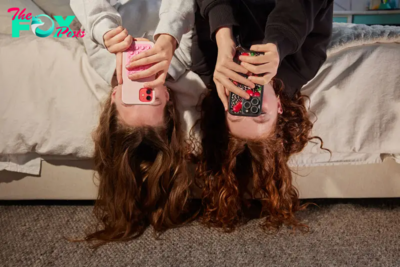Health
Breaking Up Can Be Easier If You Have a Ritual
In his song “Hearts and Bones,” Paul Simon, describing the dissolution of his marriage to Carrie Fisher, sang, “You take two bodies and you twirl them into one . . . And they won’t come undone.” The pomp and pageantry of love and commitment—whether that of a traditional wedding or a conventionally romantic night out with red roses and candles—looms large in our collective imagination. These rituals offer couples emotional generators to affirm their shared reality and identity. But rituals can also provide opportunities for much-needed transitions when ending relationships, whether we call it breaking up, divorcing, or separating.
Can couples craft new rituals to help them decouple—to acknowledge that their once-shared reality is now fragmented?
This is precisely where Ulay and Marina Abramović found themselves in the spring of 1986, despite their cosmic connection and shared birthdays. They had just performed a show together at the Burnett Miller Gallery in Los Angeles. The show, for her, was symbolic of their love and their artistic vision. It represented what she describes in her memoir, Walk Through Walls, as “creating this third element we called that self—an energy not poisoned by ego, a melding of male and female that to me was the highest work of art.”
Ulay, on the other hand, felt their performances and interactions with the spectators afterward were becoming routine. The Business and networking aspect of their art had become a habit he wasn’t sure he wanted to cultivate. Whereas Abramović was ready to embrace the life of a world-famous art star—with its requisite duties and attendant inconveniences—Ulay longed to live a more itinerant and anarchist existence. Instead of attending Celebrity parties and art pavilions, he was eager to return to his nomadic life Traveling across Europe in a van.
“Oh, you know how to deal with people,” he told Abramović while she worked the room at the show’s after-party. “I’m just going to have a walk.” During his lengthy absence, Abramović later found out that Ulay was cheating on her with a beautiful young gallery assistant. It was (another) tale as old as time.
How do two people who have spent more than a decade making work about becoming inextricably linked find a way to call it off? The artists did the most reasonable thing they could think of doing given the circumstances: they devised their own unique ritual for breaking up. They decided to take the better part of a year to walk the Great Wall of China together—each starting from an opposite end of its 13,171 miles—and meet in the middle to say goodbye. The project—initially called The Lovers and conceived of as a kind of wedding—had turned, over years of waiting and broken trust, into a meditation on their incompatibility and separation. On March 30, 1988, after close to a decade of cutting through bureaucratic red tape from the Chinese Communist Party, the artists were finally granted permission to perform their walk. Abramović started at the Bohai Sea, a part of the Yellow Sea, which sits between China and Korea. Over months of trekking, she walked the more treacherous path through eastern China’s elevations and along parts of the path that had been destroyed to only shards of crumbling rock and stone under Mao’s Communist diktats. She and her guides had to walk hours from the wall each night just to reach the villages where they slept.
Ulay set out 700 miles to the west in the Gobi Desert. While Abramović had the mountains to conquer, much of Ulay’s journeys took him through hundreds of miles of desert dunes. Instructed to lodge in the nearby villages and hostels, he characteristically broke the rules and spent many of his nights sleeping under the stars on the broken stones of the Great Wall. Both of them invested extreme effort in putting their bodies in motion to prepare for the moment of meeting again and severing all ties to each other.
After each walking for 90 days and covering around twelve and a half miles a day, the artists reunited on a stone bridge in Shaanxi Province. Ulay arrived first and sat down to wait. Abramović eventually approached toward the end of the day. They looked at each other as they had once done so many years ago in that Amsterdam airport, and they embraced. They then parted ways and did not speak again for 22 years.
Read More: This Is the Best Way to Break Up With Someone, According to Experts
Ulay and Abramović might be an extreme example, but we can still glean guidance from them when facing our own breakups. Colleen Leahy Johnson, an expert in the psychological impact of divorce, uses the wonderful phrase “socially controlled civility” to describe how former couples can move past their acrimony by engaging in patterned, symbolic ceremonies—that is, rituals—that help them to keep their emotions in check. One divorcing couple chose to have their dissolution ceremony in their church and created reverse vows: “I return these rings which you gave me when we married, and in so doing I release you from all marital responsibilities toward me. Will you forgive me for any pain I have caused you?” The ceremony was so moving that one attendee later had an epiphany: “Too often I see a ritual as an ending to a process without realizing at the same time it is a new beginning.”
The philosopher and public intellectual Agnes Callard crafted her own, unique new beginning. She now lives with her ex-husband, Ben Callard, a fellow philosopher, as well as her former graduate student, now husband, Arnold Brooks, in one household. The three adults have shared domestic and caretaking duties with their three children—two from her marriage with Callard and one from her current marriage with Brooks. Because she and her ex-husband are still close, the two of them celebrate their divorce every year with their own unique ritual. “Happy Divorciversary to us! This is a big one: #10,” she wrote on her Twitter feed with a picture of her beaming next to Ben. They went out to dinner and savored the joys of growing old together—over a decade of successful divorcing is nothing to sneer at. “Remember kids, marriages come and go but divorce is forever so choose your exes wisely,” she quipped on social media.
The equanimity of the domestic situation of these three might be hard for many people to emulate, but luckily there’s a ritual for less amicable former couples, too: the “annivorcery.” An investment banker named Gina noted, “I’ve been divorced for three years, and each year I throw a big party to celebrate my separation. I make my ex look after the kids while I invite all my best single boyfriends and girlfriends.”
Paul Simon felt that once couples were twirled into one, there was no undoing the bond. And moving on from meaningful relationships is, for sure, one of the hardest transitions we have to make in our lives. Given the pain involved, it’s no wonder that people have devised so many different means of moving on. Think of Gwyneth Paltrow and Chris Martin’s stated plan to engage in “conscious uncoupling” when announcing their divorce. The pair met with some ridicule, but in its essence, conscious uncoupling is a guided ritual that helps couples let go of each other without burning bridges. Though, in a pinch, a little fire can help as well—we could simply borrow from Taylor Swift’s relationship-ending ritual of striking a match on the time she spent with her ex, who’s now “just another picture to burn.”
Excerpted from THE RITUAL EFFECT: From Habit to Ritual, Harness the Surprising Power of Everyday Actions, copyright © 2024 by Michael Norton, PhD. Reprinted by permission from Scribner, an imprint of Simon & Schuster, LLC. All rights reserved. No part of this excerpt may be reproduced or reprinted without permission in writing from the publisher.
-

 Health1d ago
Health1d agoThe Surprising Benefits of Talking Out Loud to Yourself
-

 Health1d ago
Health1d agoDoctor’s bills often come with sticker shock for patients − but health insurance could be reinvented to provide costs upfront
-

 Health2d ago
Health2d agoHow Colorado is trying to make the High Line Canal a place for everyone — not just the wealthy
-

 Health2d ago
Health2d agoWhat an HPV Diagnosis Really Means
-

 Health2d ago
Health2d agoThere’s an E. Coli Outbreak in Organic Carrots
-

 Health3d ago
Health3d agoCOVID-19’s Surprising Effect on Cancer
-

 Health3d ago
Health3d agoColorado’s pioneering psychedelic program gets final tweaks as state plans to launch next year
-

 Health4d ago
Health4d agoWhat to Know About How Lupus Affects Weight





















